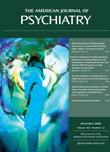Amantadine-Induced Psychosis in a Young Healthy Patient
To the Editor: Young, healthy patients may experience side effects of amantadine that are more commonly seen in elderly patients, in instances of overdose, or in individuals with renal impairment (1 , 2) . We report the case of the onset of visual and auditory hallucinations following the use of amantadine for the treatment of influenza.
“Mr. A” was a 19-year-old Caucasian man who was initially seen in our unit for sleep difficulty and depressed mood. He had been experiencing difficulty adapting to a new work environment. At his initial visit, the patient denied any current manic or psychotic symptoms or history of these symptoms. After the initial visit, he was prescribed venlafaxine, 75 mg daily, for depressive symptoms and quetiapine, 25 mg nightly, for sleep difficulty. After 2 weeks of treatment with venlafaxine and quetiapine, the patient reported that he was able to sleep better and that he felt “calmer” during the day and his mood had improved noticeably.
Five weeks after the initiation of treatment, the patient developed flu-like symptoms and was prescribed amantadine, 100 mg twice daily, which is a standard treatment dose for influenza A. The following day, he reported to his psychiatrist and complained of feeling “weak” and that he had been “hallucinating.” He described auditory hallucinations of a guitar playing and visual hallucinations of a person playing the guitar while he was in a cafeteria with a group of friends. Other people confirmed that there was no one playing the guitar in the cafeteria.
After a review of Mr. A’s medications, amantadine was the only new medication found. He was instructed to discontinue amantadine and did not have any further episodes of auditory or visual hallucinations.
Amantadine is indicated for treatment of influenza A, parkinsonism, and drug-induced extrapyramidal reactions (3) . The mechanism of action for the latter two indications is thought to be via stimulating dopamine release (4) , and it is this mechanism of action that is thought to be responsible for the rarely seen side effect of psychosis (1 , 5) . Although amantadine-induced psychosis has been observed in nongeriatric patients, the incidence is very low and may be associated with an increased daily dose (6 , 7) . The present case demonstrates the potential for amantadine psychosis in a young, otherwise healthy individual, who was taking an appropriate dose for treatment of what was presumed to be influenza.
1. Snoey ER, Bessen HA: Acute psychosis after amantadine overdose. Ann Emerg Med 1990; 19:668–670Google Scholar
2. Borison RL: Amantadine-induced psychosis in a geriatric patient with renal disease. Am J Psychiatry 1979; 136:111–112Google Scholar
3. Symmetrel [package insert]: Chadds Ford, Penn, Endo Pharmaceuticals, 2007Google Scholar
4. Bailey EV, Stone TW: The mechanism of action of amantadine in Parkinsonism: a review. Arch Int Pharmacodyn Ther 1975; 216:246–262Google Scholar
5. Stroe AE, Hall J, Amin F: Psychotic episode related to phenylpropanolamine and amantadine in a healthy female. Gen Hosp Psychiatry 1995; 17:457–458Google Scholar
6. Flaherty JA, Bellur SN: Mental side effects of amantadine therapy: its spectrum and characteristics in a normal population. J Clin Psychiatry 1981; 42:344–345Google Scholar
7. Yang CC, Deng JF: Anticholinergic syndrome with severe rhabdomyolysis: an unusual feature of amantadine toxicity. Intensive Care Med 1997; 23:355–356Google Scholar



